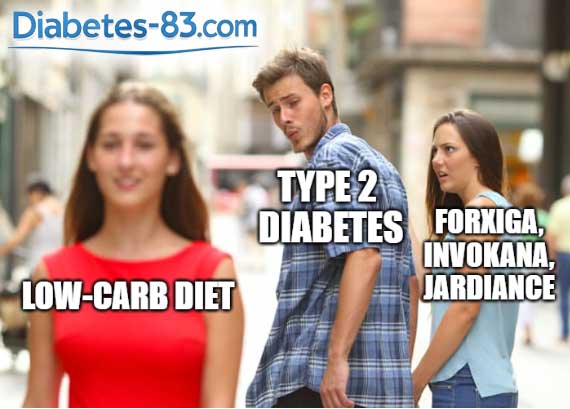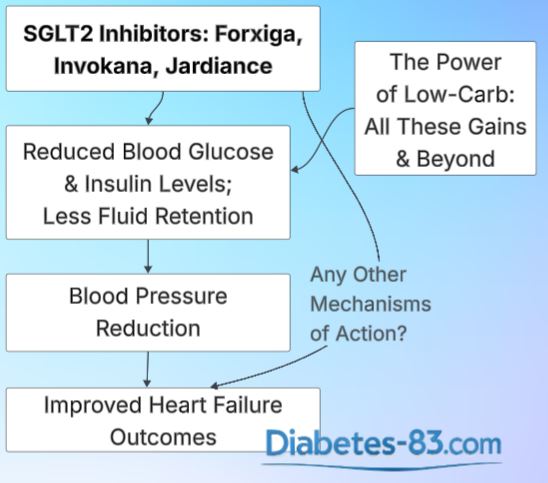Forxiga, Invokana, and Jardiance are popular medications for type 2 diabetes. They belong to a class of drugs called SGLT2 inhibitors. These drugs help lower blood sugar by forcing the kidneys to remove more glucose through urine.
They aren’t cheap, but they’re also not out of reach for most people. SGLT2 inhibitors can be a reasonable option for people with type 2 diabetes who struggle to follow a low-carb diet. However, if you already control your blood sugar well with a low-carb diabetes treatment approach, taking SGLT2 inhibitors probably won’t add much benefit.

Doctors sometimes prescribe Forxiga, Invokana, or Jardiance not just for diabetes but also in the hope that these drugs will improve heart health. Some people with heart failure take SGLT2 inhibitors even if they don’t have diabetes. In the section below, I explain whether this approach makes sense.
Forxiga, Invokana, and Jardiance: Mechanism of Action
The kidneys constantly filter the blood and remove waste products. The filtered waste is dissolved in water and excreted as urine. Under normal conditions, the kidneys only remove glucose when blood sugar rises above 170–180 mg/dL. In other words, the kidneys begin excreting glucose in the urine only when blood sugar reaches about twice the normal level.
The renal threshold for glucose is a blood sugar value at which the kidneys begin to excrete glucose. It is usually around 170–180 mg/dL. Forxiga, Invokana, and Jardiance lower this threshold significantly. Under the effect of these drugs, the kidneys start removing glucose even when blood sugar is at normal levels, around 80–90 mg/dL. If blood sugar rises, the kidneys excrete more glucose into the urine. As a result, a large portion of the glucose from carbohydrates is flushed out of the body instead of persisting and getting metabolized.
Blood Sugar Reduction with SGLT2 Inhibitors
Forxiga, Invokana, and Jardiance typically lower glycated hemoglobin (HbA1c) by 0.5 to 1 percentage point (about 5–11 mmol/mol). It corresponds to a 10–20 mg/dL reduction in average blood sugar. While not dramatic, this is still a meaningful improvement for people with type 2 diabetes. Many patients appreciate that they can achieve this without following a strict diet or using insulin injections.
When you combine SGLT2 inhibitors with metformin, the drop in blood sugar can increase by 50% or even double compared to taking SGLT2 inhibitors alone. However, metformin often causes digestive side effects, especially in the first few days of treatment. Most people with type 2 diabetes find that these problems go away once their body adjusts to the medication.
Forxiga, Invokana, and Jardiance Advantages and Disadvantages
Forxiga, Invokana, and Jardiance are popular with patients for several reasons:
- They help lower blood sugar significantly without requiring a strict diet, insulin injections, or exercise.
- They are easy to take—just one pill once a day.
- Their price is moderate—not cheap, but not prohibitively expensive.
- They rarely cause severe or dangerous hypoglycemia.
- Many pharmacies offer convenient combination pills that include both an SGLT2 inhibitor and metformin.
Doctors appreciate these drugs because patients rarely resist the prescription or ask many questions. It makes SGLT2 inhibitors much easier to prescribe compared to insulin. Additionally, pharmaceutical companies promote Forxiga, Invokana, and Jardiance by highlighting their potential benefits for heart and kidney health.
The main drawback of SGLT2 inhibitors is that they don’t work as well as a low-carb diet for controlling diabetes. Unlike a low-carb approach, Forxiga, Invokana, and Jardiance don’t lower blood sugar to the normal range of healthy people. While these drugs do reduce blood sugar, levels usually remain above normal. It means a higher risk of complications like eye, leg, or kidney problems—and, ultimately, a shorter life expectancy.
Common Side Effects of SGLT2 Inhibitors
Medical journal articles often claim that Forxiga, Invokana, and Jardiance act selectively. This phrase means they target only the kidney’s threshold for glucose excretion without affecting anything else in the body. However, SGLT2 inhibitors still cause many side effects in real-world use.
Patients taking these medications often report the following side effects:
- Urinary tract infections
- Thrush, which can affect both women and men
- Increased thirst and frequent urination
- Dizziness, headaches, and nausea
- Allergic reactions
- In people with type 1 diabetes, there is a risk of life-threatening ketoacidosis
Glucose in the urine creates an ideal environment for microorganisms to grow. That is why urinary tract infections and thrush are common side effects of Forxiga, Invokana, and Jardiance. I also worry that these glucose-fed microbes might travel to the kidneys, potentially causing pyelonephritis or other serious infections.
When urine in the bladder becomes saturated with glucose, it gets more concentrated. To dilute it, the kidneys draw water from the bloodstream, which leads to dehydration. It causes thirst, dizziness, and other dehydration symptoms. Unlike urinary tract infections, this side effect is easy to prevent by drinking enough fluids.
SGLT2 Inhibitors and Heart Health Benefits
Pharmaceutical companies that produce Forxiga, Invokana, and Jardiance have worked hard to hype these drugs to doctors. They have created an exaggerated impression of how effective these medications are in preventing and treating heart failure. Thanks to persistent marketing, SGLT2 inhibitors are now often prescribed to heart failure patients who don’t have diabetes.
I’m skeptical about using Forxiga, Invokana, and Jardiance to prevent or treat heart failure for several reasons:
- Many lead researchers behind the studies supporting SGLT2 inhibitors’ benefits in heart failure had strong financial ties to the drug makers.
- The authors, editors, peer reviewers, medical conference speakers, and health officials often have financial interests linked to these drugs.
- Despite thorough searching, I haven’t found a clear explanation of how these medications directly affect the heart.
A detailed discussion of corruption among medical regulators is beyond the scope of this article. The pharmaceutical companies have bought up all the people responsible for monitoring the safety and effectiveness of new drugs.

Patients have only one reliable way to navigate this situation: be wary of all new medications for chronic diseases. Never rush to use them as soon as they hit the market. Instead, wait several years—or even decades—before considering them.
The companies behind Forxiga, Invokana, and Jardiance claim these drugs act very selectively. They say the medications affect only the kidneys by lowering the renal threshold for glucose excretion. If true, how do these drugs influence the heart directly and treat heart failure? I have investigated this issue thoroughly but haven’t found a clear explanation.
Lowering blood sugar in people with type 2 diabetes indirectly reduces the risk of heart failure. It is a fact. Here’s how it works:
- When there is less excess glucose in the blood, the beta cells have to produce less insulin, and patients need fewer insulin injections.
- With less insulin, the body retains less excess fluid.
- Removing this extra fluid helps lower blood pressure and reduce swelling.
- Lower blood pressure means less strain on the heart and a lower risk of heart failure.
However, these benefits alone don’t justify taking SGLT2 inhibitors. Switching to a low-carb diet can provide all these advantages—and more. Read more about why a low-carb diet is the right choice for diabetes. Unlike Forxiga, Invokana, and Jardiance, a low-carb diet doesn’t cause urinary tract infections or allergic reactions.

Keep in mind that my current skepticism about the effectiveness of SGLT2 inhibitors in treating heart failure is not final. If I discover a convincing explanation of how these drugs work on the heart, I’m open to changing my opinion. If that happens, I will share this information immediately with everyone who follows me on social media.
Conclusion
Forxiga, Invokana, and Jardiance can be good options for people with type 2 diabetes who find it difficult to follow a low-carb diet. While these drugs have drawbacks and side effects, as outlined above, taking them is still better than leaving high blood sugar untreated.
Taking SGLT2 inhibitors is probably a bad idea for people with diabetes who follow a low-carb diet. The main goal should be to lower blood sugar to a healthy range and keep it consistently there. Diet alone might not be enough to achieve it. Instead of relying on Forxiga, Invokana, or Jardiance to bring blood sugar down to normal levels, consider using metformin, cardio, strength training, and low-dose insulin injections if needed.